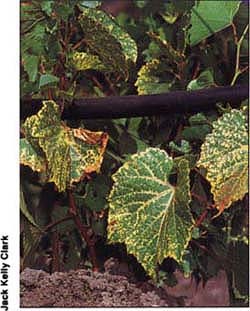All Issues
Science Briefs
Publication Information
California Agriculture 48(2):8-8.
Published March 01, 1994
PDF | Citation | Permissions
Full text
Mystery disease spotted in vineyards
Several young vineyards in Napa and Sonoma counties have been ailing from a disease that has thus far stumped viticulturists.
Typical leaf symptoms include a wide range of patterns of veinal and interveinal chlorosis. In some cases, the leaves lose their green coloring and appear bleached. Marginal burning, usually in sections of the leaf, often accompanies the chlorosis. Shoot growth stops prematurely and the vines are usually stunted.
Having ruled out herbicide injury and common viruses as causes, Napa County Farm Advisor Ed Weber is planning to conduct trials this spring. According to Weber, a lack of mycorrhizal fungi in fumigated soil may be the root of the problem. These fungi play an important role in the uptake of micronutrients in grapevines' root systems, so he theorizes an unusual nutrient deficiency may be causing the disease.
“We will be innoculating mycorrhizae into symptomatic vineyards and to new vineyards planted this spring,” Weber said.
Barley engineered
UC Berkeley plant biologists Peggy Lemaux and Yuechun Wan have introduced viral genes into barley to help the plant resist barley yellow dwarf virus. The virus, ranked among the most problematic barley diseases, weakens plants and lowers crop yields.
The researchers published the first article describing the successful barley gene insertion technique, which they developed at the Plant Gene Expression Center in Albany, in the January issue of Plant Physiology.
Federal permits have been issued for field tests to be held this summer in California, Idaho and Illinois.





